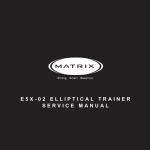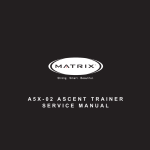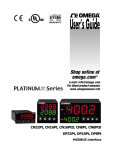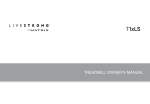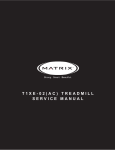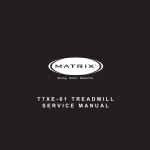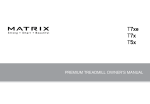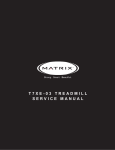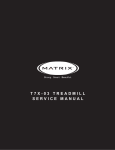Download Matrix T3X-02 Specifications
Transcript
T3x-02 Treadmill S ER V I C E MA N U A l table of contents CHAPTER 1: Serial number location . .......................................................... 1 CHAPTER 2: Important Safety instructions 2.1 2.3 2.4 Before Getting Started ................................................................................................ 2 Read and Save These Instructions ............................................................................ 3 Electrical Requirements .............................................................................................. 4 CHAPTER 3: Preventative Maintenance 3.1 3.2 3.3 3.4 3.5 3.6 Recommended Cleaning Tips . ................................................................................... 5 Check for Damaged Parts .......................................................................................... 5 Care and Maintenance Instructions ............................................................................ 6 Preventative Maintenance Checklist . ......................................................................... 6 Auto Calibration Procedure.......................................................................................... 7 Adjusting the Running Belt ......................................................................................... 7 CHAPTER 4: USING THE CONSOLE and program description 4.1 4.2 4.3 4.4 4.5 Console Description . .................................................................................................. Manual Workout Operation.......................................................................................... Operating Level Based Programs . ............................................................................. Target Heart Rate Control Workout Operation............................................................. Gerkin Fitness Test Workout Operation....................................................................... 8 9 9 10 10 CHAPTER 5: Manager MODE 5.1 5.2 Using Manager Mode ................................................................................................. 13 Manager Mode Overview............................................................................................. 14 CHAPTER 6: ENGINEERING MODE 6.1 6.2 Using Engineering Mode ............................................................................................ 15 Engineering Mode Overview........................................................................................ 15 CHAPTER 7: SERVICE MODE: 7.1 7.2 Using Service Mode.................................................................................................... 16 Service Mode Overview.............................................................................................. 16 CHAPTER 8: Troubleshooting 8.1 8.2 8.3 Electrical Diagram . ..................................................................................................... 17 Troubleshooting - Error Codes..................................................................................... 18 Troubleshooting - Heart Rate Issues........................................................................... 19 CHAPTER 9: PART REPLACEMENT GUIDE 9.1 9.2 9.3 9.4 9.5 Plastic Shroud Removal............................................................................................... 20 Rear Roller Replacement ........................................................................................... 21 Deck Removal . ........................................................................................................... 22 Deck Cushion Replacement........................................................................................ 23 Front Roller Replacement............................................................................................ 24 i table of contents 9.6 9.7 9.8 9.9 9.10 9.11 9.12 9.13 9.14 9.15 9.16 9.17 9.18 9.19 9.20 9.21 9.22 9.23 Running Belt Removal ................................................................................................ 25 Side Rail Replacement................................................................................................ 26 Motor Control Board (MCB) Replacement . ................................................................ 27 Motor Replacement...................................................................................................... 28 Drive Belt Replacement .............................................................................................. 30 Speed Sensor Replacement ....................................................................................... 32 Daughter Board Replacement..................................................................................... 33 Incline / Elevation Motor Replacement........................................................................ 34 Console Replacement .................................................................................................... 36 Emergency Stop Switch Replacement............................................................................ 37 Console Frame Replacement...................................................................................... 39 Heart Rate Board Replacement................................................................................... 40 Speed and Incline Keypads Replacement . ................................................................ 41 Handlebar Replacement ............................................................................................. 42 Heart Rate Handlebar Replacement............................................................................ 43 Heart Grips Replacement............................................................................................ 44 Console Mast Replacement......................................................................................... 45 Testing the Treadmill.................................................................................................... 46 CHAPTER 10: Treadmill specifications and assembly guide 10.1 10.2 10.3 Treadmill Specifications............................................................................................... 47 Fasteners and Assembly Tools.................................................................................... 48 Assembly Instructions ................................................................................................. 49 CHAPTER 11: SOFTWARE UPGRADE INSTRUCTIONS 11.1 ii iv Software Upgrade Instructions..................................................................................... 53 Chapter 1: Serial number location 1.1 Serial Number Location 1 Chapter 2: Important Safety Instructions 2.1 Before Getting Started This treadmill is intended for commercial use. To ensure your safety and protect the equipment, read all instructions before operating the Matrix Treadmill. Please leave a 78.75" (2000 mm) x 39.50" (1000 mm) landing zone behind the treadmill. This zone is to allow easy access to the treadmill and gives the user an easy exit path from the machine. In case of an emergency, place both hands on the side arm rests to hold yourself up and place your feet onto the side rails. 2 Chapter 2: Important Safety Instructions 2.2 Read and Save these instructions This treadmill is intended for commercial use. To ensure your safety and protect the equipment, read all instructions before operating the MATRIX T3x-02 treadmill. When using an electrical product, basic precautions should always be followed including the following: DANGER: To reduce the risk of electric shock: Always unplug this equipment from the electrical outlet immediately after using and before cleaning. WARNING: To reduce the risk of burns, fire, electrical shock or injury to persons that may be associated with using this product. CAUTION: If you experience chest pain, nausea, dizziness or shortness of breath, STOP exercising immediately and consult a physician before continuing. • D o not use the equipment in any way other than designed or intended by the manufacturer. It is imperative that all Matrix Fitness System's equipment is used properly to avoid injury. • Keep hands and feet clear of moving parts at all times to avoid injury. • Unsupervised children must be kept away from this equipment. • Do not wear loose clothing while on equipment. An appliance should never be left unattended when plugged in. Unplug from the outlet when not in use and before putting on or taking off parts. This product must be used for its intended purpose described in this service manual. Do not use other attachments that are not recommended by the manufacturer. Attachments may cause injury. To prevent electrical shock, never drop or insert any object into any opening. Do not remove the console covers. Service should only be done by an authorized service technician. Never operate the treadmill with the air opening blocked. Keep the air opening clear, free of lint and hair. Never operate product if it has a damaged cord or plug, if it is working improperly, if it has been damaged, or immersed in water. Do not carry this unit by its supply cord or use the cord as a handle. Keep any power cord away from heated surfaces. Close supervision is necessary when the treadmill is used by or near children or disabled persons. Do not use outdoors. Do not operate where aerosol (spray) products are being used or when oxygen is being administered. To disconnect, turn all controls to the off position, then remove plug from the outlet. Connect this treadmill to properly grounded outlets only. 3 Chapter 2: Important Safety Instructions 2.3 Electrical Requirements For your safety and to ensure good treadmill performance, the ground on this circuit must be non-looped. Please refer to NEC articles 210-21 and 210-23. Your treadmill is provided with a power cord with a plug listed below and requires the listed outlet. Any alterations of this power cord could void all warranties of this product.. Matrix dedicated circuit / electrical requirement info All Matrix treadmills require the use of a 20 amp "dedicated circuit" with a non-looped (isolated) neutral / ground for the power requirement. Quite simply this means that each outlet you plug your treadmill into should not have anything else running on that same circuit. The easiest way to verify this is to locate the main circuit breaker box, and turn off the breaker(s) one at a time. Once a breaker has been turned off, the only thing that should not have power to it is the treadmill. No lamps, vending machines, fans, sound systems, or any other item should lose power when you perform this test. Non-looped (isolated) neutral / grounding means that each circuit must have an individual neutral / ground connection coming from it, and terminating at an approved earth ground. You cannot "jumper" a single neutral / ground from one circuit to the next. In addition to the dedicated circuit requirement, the proper gauge wire must be used from the circuit breaker box, to each outlet that will have the maximum number of units running off of it. If the distance from the circuit breaker box, to each outlet, is 100 feet or less, then 12 gauge wire may be used. For any distance greater than 100 feet from the circuit breaker box to the outlet, 10 gauge wire must be used. 4 Chapter 3: PREVENTATIVE MAINTENANCE 3.1 recommended cleaning tips 3.2 Check for damaged parts Preventative maintenance and daily cleaning will prolong the life and look of your MATRIX T3x-02 Treadmill. DO NOT use any equipment that is damaged or has worn or broken parts. Use only replacement parts supplied by Matrix Fitness Systems. Please read and follow these tips. • P osition the equipment away from direct sunlight. The intense UV light can cause discoloration on plastics. • L ocate your equipment in an area with cool temperatures and low humidity. • Clean with a soft 100% cotton cloth. • C lean with soap and water or other non-ammonia based all purpose cleaners. • W ipe foot rails, console, heart rate grips, and handlebars clean after each use. MAINTAIN LABELS AND NAMEPLATES. Do not remove labels for any reason. They contain important information. If unreadable or missing, contact Matrix Fitness Systems for a replacement at 866-693-4863 or www.matrixfitness.com. MAINTAIN ALL EQUIPMENT. Preventative maintenance is the key to smoothly operating equipment. Equipment needs to be inspected at regular intervals. Defective components must be kept out of use until they are repaired. Ensure that any person(s) making adjustments or performing maintenance or repair of any kind is qualified to do so. Matrix Fitness Systems will provide service and maintenance training at our corporate facility upon request or in the field if proper arrangements are made. • D o not pour liquids directly onto your equipment. This can cause damage to the equipment and in some cases electrocution. • Check the running belt for proper tension and routing. • Adjust the leveling feet when equipment wobbles or rocks. • Maintain a clean area around equipment, free from dust and dirt. 5 Chapter 3: PREVENTATIVE MAINTENANCE 3.3 Care and MAINTENANCE instructions In order to maximize life span, and minimize down time, all Matrix Fitness System's equipment requires regular cleaning, and maintenance items performed on a scheduled basis. This section contains detailed instructions on how to perform these items and the frequency of which they should be done. Some basic tools and supplies will be necessary to perform these tasks which include (but may not be limited to): * Metric Allen wrenches * #2 Phillips head screwdriver * Adjustable wrench * Torque wrench (capability to read foot lbs and inch lbs) * Lint free cleaning cloths * Teflon based spray lubricant such as "Super Lube" or other Matrix approved products. * Mild water soluble detergent such as "Simple Green" or other Matrix approved products * Vacuum cleaner with an extendable hose and crevasse tool attachment. You may periodically see addendums to this document, as the Matrix Technical Support Team identifies items that require specific attention, the latest version will always be available on the Matrix web site at www.matrixfitness.com. DAILY MAINTENANCE ITEMS 1) Clean the entire machine using water and mild detergent such as "Simple Green", or other Matrix approved solutions (cleaning agents MUST be alcohol and ammonia free). 2) Check the emergency stop button and cord for proper operation. MONTHLY MAINTENANCE ITEMS 1) Inspect the power cord for damage, inspect the hand grip areas, and inspect the emergency stop button and cord for proper operation. 2) Check the running belt for proper tension, adjust as needed. QUARTERLY MAINTENANCE ITEMS 1) Remove the front plastic cover, and vacuum the entire inside area of machine. Be careful when working around the MCB not to bump any wires or connections loose. 6 2) Check the drive belt for visible wear, ie, cracking, tears, etc. The belt should be replaced if there are any visible signs of damage. Proper alignment of the pulley / tensioner should be verified at this time as well. 3) Remove the plastic shroud at the front of the machine. Start the unit and raise the incline settings to maximum height. Turn the power switch off at the front of the machine to prevent it from lowering accidentally. Lubricate the incline motor Acme screw (Matrix recommends Super Lube brand grease with PTFE additive). BI-ANNUAL MAINTENANCE ITEMS 1) Remove any wax build up from the front and rear rollers of the machine. 2) Inspect the underside of the running belt for damage, check for cracking or glazed surfaces. 3) If the belt has damage or wear to it that warrants replacement, note that a new running belt should ALWAYS be installed on a new deck surface (deck should either be flipped or replaced to gain a new surface). 4) During normal operating conditions, the running belt replacement and deck service should be done every 15,000 miles. Chapter 3: Preventative Maintenance 3.4 Auto calibration instructions Run Auto Calibration to calibrate incline after assembly and after replacing any electronic component. AUTO CALIBRATION PROCEDURE: 1) Press and hold the INCLINE DOWN and SPEED DOWN keys for three seconds until Manager appears on the middle LED display. 2) Press the SPEED or INCLINE UP key until Engineering appears on the display. 3) Press ENTER once Engineering is displayed. 4) Scroll between programs in the Engineering Mode using any UP or DOWN key until Auto Calibration appears on the middle LED display. 5) Press ENTER once Auto Calibration is displayed., you should not be standing on the running belt. 6) After completion, the display will either return to normal operation (if the unit passed the Auto Calibration) or display that the Auto Calibration failed. 3.5 Adjusting the running belt After placing the treadmill in the position it will be used, the belt must be checked for proper tension and centering. The belt may need to be adjusted after the first 2 hours of use. Temperature, humidity, and use cause the belt to stretch at different rates. If the belt starts to slip when a user is on it, be sure to follow the directions below. STEP 1: Locate the two hex head bolts on the rear of the treadmill. The bolts are located at each end of the frame at the back of the treadmill. These bolts adjust the rear roller. Do not adjust until the treadmill is on. This will prevent over tightening of one side. STEP 2: The belt should have equal distance on either side between the frame. If the belt is touching one side, do not start the treadmill. Turn the bolts counter clockwise approximately one full turn on each side. Manually center the belt by pushing the belt from side to side. Tighten the bolts the same amount as when the user loosened them, approximately one full turn. Inspect the belt for damage. STEP 3: While the treadmill is running at 3 mph, observe the belt position. If it is moving to the right, tighten the right bolt by turning it clockwise 1/4 turn, and loosen the left bolt 1/4 turn. If it is moving to the left, tighten the left bolt by turning it clockwise 1/4 turn and loosen the right 1/4 turn. Repeat Step 3 until the belt remains centered for several minutes. STEP 4: Check the tension of the belt. The belt should be very snug. When a person walks or runs on the belt, it should not hesitate or slip. If this occurs, tighten the belt by turning both bolts clockwise 1/4 turn. Repeat if necessary. 7 Chapter 4: Console Overlay and workout description 4.1 T3x-02 Console Description WORKOUT KEYS: Simple program view and selection buttons. GO: One touch Start and Quick Start. ENTER: To confirm each program setting. UP / DOWN INCLINE: Easy information and incline selection. UP / DOWN SPEED: Easy information and speed selection. EMERGENCY STOP / IMMOBILIZATION: To stop all functions and immobilize the unit. The emergency stop on this treadmill must be returned to its original position in order to allow normal operation of the unit. STOP: Ends workout and shows workout summary data. PAUSE: Pauses workout. Pause duration can be set in Manager Mode. COOL DOWN: Puts treadmill into Cool Down mode. Cool Down time is dependent on the length of the workout. Workouts 19 minutes and shorter will have a cool down length of 2 minutes. Workouts 20 minutes and longer will have a cool down length of 5 minutes. 8 Chapter 4: Console overlay and workout description 4.2 Manual Workout Operation QUICK START OPERATION Press the GO button(s) and the treadmill will enter into a manual mode of operation. All energy expenditure values will be calculated using the default weight measurement. MANUAL WORKOUT OPERATION Manual is a workout that allows you to manually adjust the speed and incline values at anytime. The manual workout also contains a setup screen which allows you to input your weight to help calculate a more accurate caloric burn rate. To enter into this Manual Workout: 1) Choose the Manual Workout by selecting the MANUAL WORKOUT button and press ENTER. 2) Enter the desired workout length using the INCLINE or SPEED KEYS and press ENTER. 3) Enter the user's weight (the user's weight is used to calculate the caloric expenditure value-providing an accurate weight helps to ensure an accurate caloric expenditure rating for each user) using the INCLINE or SPEED KEYS and press ENTER. 4) Enter the desired initial incline value using the INCLINE or SPEED KEYS and press ENTER. 5) Enter the desired start speed using the INCLINE or SPEED KEYS and press ENTER. 6) Press GO to begin the workout. The display will read 3, 2, 1, and then the workout will begin. 4.3 level based workout operation Your Matrix T3x-02 Treadmill offers a variety of level-based workouts to challenge users of all fitness levels. The following information will briefly explain the workouts and how to program the treadmill for each workout selection. ROLLING HILLS WORKOUT OPERATION Rolling Hills is a level based workout that automatically adjusts the incline value to simulate walking or running up hills. 1) Choose the Rolling Hills workout by selecting the ROLLING HILLS workout button and press ENTER. 2) Enter the desired intensity using the INCLINE or SPEED KEYS and press ENTER. 3) Enter the desired workout length using the INCLINE or SPEED KEYS and press ENTER. 4) Enter the user's weight (the user's weight is used to calculate the caloric expenditure value, providing an accurate weight helps to ensure an accurate caloric expenditure rating for each user) using the INCLINE or SPEED KEYS and press ENTER. 5) Press GO to begin the workout. The display will read 3, 2, 1, and then the workout will begin. FAT BURN WORKOUT OPERATION Fat Burn is a level-based workout that is designed to help users burn fat through various incline changes. 1) Choose the Fat Burn workout by selecting the FAT BURN workout button and press ENTER. 2) Enter the desired intensity level using the INCLINE or SPEED KEYS and press ENTER. 3) Enter the desired workout length using the INCLINE or SPEED KEYS and press ENTER. 4) Enter the user's weight (the user's weight is used to calculate the caloric expenditure value, providing an accurate weight helps to ensure an accurate caloric expenditure rating for each user) using the INCLINE or SPEED KEYS and press ENTER. 5) Press GO to begin the workout. The display will read 3, 2, 1, and then the workout will begin. 5K RUN WORKOUT OPERATION 5K Run is a level-based workout with a fixed distance of 5 kilometers. Incline is adjusted automatically throughout the workout. You control the speed. 1) Choose the 5K Run workout by selecting the 5K RUN workout button and press ENTER. 2) Enter the desired intensity level using the INCLINE or SPEED KEYS and press ENTER. 3) Enter the user's weight (the user's weight is used to calculate the caloric expenditure value, providing an accurate weight helps to ensure an accurate caloric expenditure rating for each user) using the INCLINE or SPEED KEYS and press ENTER. 4) Press GO to begin the workout. The display will read 3, 2, 1, and then the workout will begin. 9 Chapter 4: Console overlay and workout description 4.4 Heart rate Control Workout Operation 4.5 Fitness test workout operation Your Matrix T3x-02 Treadmill offers a heart rate control workout mode. The heart rate control workout mode allows the user to program their desired heart rate zone and maximum allowable incline and the treadmill will automatically adjust the incline based upon the user's heart rate. The heart rate zone is calculated using the following equation: (220-Age)*%=target heart rate zone. The user must wear a telemetric heart rate monitor or continually hold onto the contact heart rate grips for his workout. Your Matrix T3x-02 Treadmill offers a Gerkin Firefighter Protocol Fitness Test, The Gerkin Protocol was developed by Dr.. Richard Gerkin of the Phoenix (Arizona) Fire Department. It is a sub-maximal graded treadmill evaluation used by many fire departments across the United States to assess the physical condition of the firefighters. The test requires constant monitoring of the user's heart rate so the use of a telemetric chest strap is highly encouraged. The workout operates as follows: 1) Choose the Target Heart Rate workout by selecting the HEART RATE workout button and press ENTER. 2) Enter the user's age using the INCLINE or SPEED KEYS and press ENTER. 3) Enter the desired percent of maximum heart rate using the INCLINE or SPEED KEYS and press ENTER. 4) Enter the user's weight (the user's weight is used to calculate the caloric expenditure value, providing an accurate weight helps to ensure an accurate caloric expenditure rating for each user) using the INCLINE or SPEED KEYS and press ENTER. 5) Press GO to begin the workout. The display will read 3, 2, 1, and then the workout will begin. WARM UP: The warm up is 3 minutes long and runs at 3.0 mph (4.8 kph) and 0% incline. STAGE 1: At the 3 minute mark, the treadmill will gradually increase speed to 4.5 mph (7.2 kph). The actual test begins at 4.5 mph (7.2 kph). STAGE 2: After one minute, the treadmill incline will increase to 2%. STAGE 3: After one minute, the treadmill speed increases to 5.0 mph (8.0 kph). STAGES 4 THROUGH 11: After every odd minute the treadmill incline will increase by 2%. After every even minute the treadmill speed will increase by 0.5 mph (0.8 kph). Once the user's heart rate exceeds the target heart rate (85% of maximum as determined by the equation (220-Age)*%=target heart rate zone), the individual continues the evaluation for an additional 15 seconds. During the 15 second period, the evaluation remains at the stage where the target heart rate is exceeded, without any change to speed or incline. If the heart rate does not return to or below the target heart rate, the evaluation ends and the final evaluation stage is recorded. If the heart rate returns to or below the target heart rate, the program continues at the point where it would have been had the program not stabilized for 15 seconds. TEST COMPLETION: The test is completed when user's heart rate exceeds the target for more than 15 seconds or when the user completes all 11 stages, whichever occurs first. The treadmill will enter a cool down cycle for 3 minutes at 3.0 mph (4.8 kph), 0% incline. 1) Choose the Gerkin Test by pressing the FITNESS TEST workout button and press ENTER. 2) Enter the user's age using the INCLINE or SPEED KEYS and press ENTER. 3) The message window will display your target heart rate based upon your age and the target heart rate zone of 85%. 4) Select the user's gender using the INCLINE or SPEED KEYS and press ENTER. 5) Enter the user's weight (the user's weight is used to calculate the caloric expenditure value, providing an accurate weight helps to ensure an accurate caloric expenditure rating for each user) using the INCLINE or SPEED KEYS and press ENTER. 6) The message window will notify the user that the start speed is 3.0 mph (4.8 kph) and 0% incline during the warm-up. 7) Press GO to begin the workout. The display will read 3, 2, 1, and the workout will begin. 10 Chapter 4: Console overlay and workout description 4.5 Fitness Test workout operation - Continued Sub maximal treadmill evaluation conversion table Stage 1 2.1 2.2 2.3 2.4 3.1 3.2 3.3 3.4 4.1 4.2 4.3 4.4 5.1 5.2 5.3 5.4 6.1 6.2 6.3 6.4 7.1 7.2 7.3 7.4 8.1 8.2 8.3 8.4 9.1 9.2 9.3 9.4 10.1 10.2 10.3 10.4 11.1 11.2 11.3 11.4 Time 1:00 1:15 1:30 1:45 2:00 2:15 2:30 2:45 3:00 3:15 3:30 3:45 4:00 4:15 4:30 4:45 5:00 5:15 5:30 5:45 6:00 6:15 6:30 6:45 7:00 7:15 7:30 7:45 8:00 8:15 8:30 8:45 9:00 9:15 9:30 9:45 10:00 10:15 10:30 10:45 11:00 Converted VO2max 31.15 32.55 33.6 34.65 35.35 37.45 39.55 41.3 43.4 44.1 45.15 46.2 47.5 48.6 50 51.4 52.8 53.9 54.9 56 57 57.7 58.8 60.2 61.2 62.3 63.3 64 65 66.5 68.2 69 70.7 72.1 73.1 73.8 74.9 76.3 77.7 79.1 80 CARDIOVASCULAR FITNESS PERCENTILeS Males: SUPERIOR EXCELLENT GOOD FAIR POOR VERY POOR VO2 max (ml/kg/min) 0-29 30-39 40-49 50-59 >58.8 >58.9 >55.4 >52.5 54.0 52.5 50.4 47.1 51.4 50.3 48.2 45.3 48.2 46.8 44.1 41.0 46.8 44.6 41.8 38.5 44.2 42.4 39.9 36.7 42.5 41.0 38.1 35.2 41.0 38.9 36.7 33.8 39.5 37.4 35.1 32.3 37.1 35.4 33.0 30.2 34.5 32.5 30.9 28.0 31.6 30.9 28.3 25.1 Females: SUPERIOR EXCELLENT GOOD FAIR POOR VERY POOR VO2 max (ml/kg/min) 20-29 30-39 40-49 50-59 >53.0 >48.7 >46.8 >42.0 46.8 43.9 41.0 36.8 44.2 41.0 39.5 35.2 41.0 38.6 36.3 32.3 38.1 36.7 33.8 30.9 36.7 34.6 32.3 29.4 35.2 33.8 30.9 28.2 33.8 32.3 29.5 26.9 32.3 30.5 28.3 25.5 30.6 28.7 26.5 24.3 28.3 26.5 25.1 22.3 25.9 25.1 23.5 21.1 11 Chapter 4: Console Overlay and workout description 4.5 Fitness Test workout operation - Continued The Military Test programs and the Physical Efficiency Battery (PEB) provide workouts of a preset distance. These distances are established by the various branches of the Military with the objective of each test to complete the distance as quickly as possible. At the completion of the test, a time-based score as defined by the respective Military branch will be shown on the console. 1) Choose your Military Test by pressing the FITNESS TEST button until the desired test is shown on the screen. 2) Enter the user's age using the INCLINE or SPEED KEYS and press ENTER. 3) Select the user's gender using the INCLINE or SPEED KEYS and press ENTER. 4) Enter the user's weight (the user's weight is used to calculate the caloric expenditure value, providing an accurate weight helps to ensure an accurate caloric expenditure rating for each user) using the INCLINE or SPEED KEYS and press ENTER. 5) Enter the desired intensity level using the INCLINE or SPEED KEYS and press ENTER. 6) Press GO to begin the workout. The display will read 3, 2, 1, and the workout will begin. 12 Chapter 5: MANAGER MODE 5.1 Using Manager Mode 1) To enter Manager Mode, press & hold INCLINE DOWN and SPEED DOWN keys at the same time for 3-5 seconds until Manager appears on the display. 2) To enter the Manager Mode, press ENTER once Manager Mode appears on the display (Figure A). 3) To scroll between settings in the Manager Mode, press the INCLINE or SPEED keys. 4) Press ENTER to modify the settings once displayed. 5) Press any INCLINE or SPEED key to change the value of the setting. 6) Once the setting is correct, press ENTER to save. 7) Press the EMERGENCY STOP to exit Manager Mode.. Figure A 13 Chapter 5: MANAGER MODE 5.2 Manager mode overview Custom Settings 14 Default Minimum Maximum Unit description Maximum Time 60 5 95 Minute Maximum workout duration. Default Time 60 5 95 (limited to max time setting) Minute Default start time in all programs. Default level 1 1 10 Level Default start level in all programs. default Age 30 15 100 Age Default age used in HR programs. default weight 150 lb / 68 KG 80 lb / 36 KG 400 lb / 182 kg Pound / Kilogram Default weight used in calorie calculations and HR programs. accumulated distance N/A N/A 65,000 Miles / 104,000 KM Mile / Kilometer Total distance on treadmill, not editable. TO RESET: Press and hold INCLINE DOWN and SPEED DOWN for 3-5 seconds. accumulated time N/A N/A 65,000 hours Hour Total time on treadmill, not editable. TO RESET: Press and hold INCLINE DOWN and SPEED DOWN for 3-5 seconds. software N/A N/A N/A N/A Software Version, not editable. start speed 1.0 MPH / 1.6 KPH 0.5 MPH / 0.8 KPH 2.0 MPH / 3.2 KPH MPH / KPH Controls the starting speed for all programs (does not affect minimum speeds). maximum speed 12 MPH / 20 KPH 2.0 MPH / 3.2 KPH 12 MPH / 20 KPH MPH / KPH Controls the maximum speed for all programs. timer mode Down Down UP N/A Controls whether the user time counts up or down. speed mode Mile Mile Kilometer N/A Measurement unit used for calorie calculations, distance, and speed. out of order No No Yes N/A Locks the machine. gender Male Male Female N/A Sets the user's gender. language English N/A N/A N/A Sets the language shown on the console. sound mode On On OFF N/A Controls whether the display broadcasts chime when buttons are pressed. Chapter 6: Engineering MODE 6.1 USING Engineering mode 1) To enter Engineering Mode, press & hold the INCLINE DOWN and SPEED DOWN keys at the same time for 3-5 seconds until Manager Mode appears on the display. 2) Press the INCLINE or SPEED keys until Engineering Mode appears on the display (Figure A) and press ENTER. 3) To scroll between settings in the Engineering Mode, press the INCLINE or SPEED keys. 4) Press ENTER to modify the settings once displayed. 5) Press any INCLINE or SPEED key to change the value of the setting. 6) Once the setting is correct, press ENTER to save. 7) Press the EMERGENCY STOP to exit Engineering Mode.. FIGURE A 6.2 Engineering Mode OVerview Custom Setting Default Minimum Maximum Unit Description Disable Errors ON ON OFF N/A Resets error log. Accomplished by pressing INCLINE DOWN and SPEED DOWN for 3-5 seconds. Elevation Minimum 28 20 239 N/A Controls the low incline parameter. Elevation Maximum 230 20 239 N/A Controls the high incline parameter. Auto Calibration N/A N/A N/A N/a This function is to calibrate the treadmill incline. Speed Units Mile Mile Kilometer distance Measurement unit used for calorie calculations, distance, and speed. Pause Time 30 seconds 5 seconds 10 minutes second / minute Controls the maximum time the treadmill can be paused during a workout. Machine Type N/A N/A N/A N/a Sets the machine ID, not editable. Reset Defaults N/A N/A N/A N/A Reset the default values to factory settings. 15 Chapter 7: Service Mode 7.1 Using Service Mode 1) To enter Service Mode, press & hold the INCLINE DOWN and SPEED DOWN keys at the same time for 3-5 seconds until Manager Mode appears on the display. 2) Press the INCLINE or SPEED keys until Service Mode appears on the display (Figure A) and press ENTER. 3) To scroll between settings in the Service Mode, press the INCLINE or SPEED keys. 4) Press ENTER to modify the settings once displayed. 5) Press any INCLINE or SPEED key to change the value of the setting. 6) Once the setting is correct, press ENTER to save. 7) Press the EMERGENCY STOP to exit Service Mode.. FIGURE A 7.2 Service Mode OVerview Custom Settings 16 Description Service 1 Display Test Service 2 Keypad Test Service 3 Accumulated Distance / Accumulated Time Service 4 Error Log Message Chapter 8: TROUBLESHOOTING 8.1 Electrical Diagram 17 Chapter 8: Troubleshooting 8.2 ERROR CODE list ERROR CODE 18 DESCRIPTION SOLUTIONS 0x0140 Incline motor failure. 1. Reconnect the incline motor. 2. Check the incline motor connection to the elevation rack. 3. Replace the incline motor. 0x0141 Drive motor is over temperature. 1. Check the amp draw of the treadmill with a load. Change the deck or running belt if a high amp draw is present. 2. Adjust the tension of the running belt if needed. 3. Make sure that the base frame fan is running. 4. Replace the motor. 0x01A0 Incline motor signal not received. 1. Reconnect the incline motor. 2. Check the incline motor connection to the elevation rack. 3. Replace the incline motor. 0x01A8 Drive motor over current. 1. Check the amp draw of the treadmill with a load. Change the deck or running belt if a high amp draw is present. 2. Adjust the tension of the running belt if needed. 3. Make sure that the base frame fan is running. 4. Replace the motor. 0x0242 LCB is over temperature. 1. Make sure that the base frame fan is running. 2. Replace the LCB. 0x02A0 Speed sensor is disconnected or has failed. 1. 2. 3. 4. 0x02A2 Over DC bus voltage. 1. Replace the drive motor. 0x02A4 U phase current sensor and circuit has failed. 1. Replace the drive motor. 0x02A5 V phase current sensor and circuit has failed. 1. Replace the drive motor. 0x02AB LCB type setting fault. 1. Make sure that the base frame fan is running. 2. Replace the LCB. Reconnect the speed sensor to the LCB. Clean the speed sensor and optic disc. Replace the speed sensor. Replace the LCB. Chapter 8: Troubleshooting 8.3 troubleshooting - Heart Rate issues heart rate function does not work or is reading incorrectly possible causes: 1) 2) 3) 4) 5) 6) The The The The The The chest strap being used is not making good contact with the user's chest. chest strap is at a low battery status. chest strap is damaged. HR grips are damaged. HR board is damaged. UCB is damaged. SOLUTION: 1) Re-center the chest strap below the user's pectoral muscle (Figure A) and check again. 2) Replace the battery in the chest strap. 3) Replace the chest strap. 4) If there is no HR present, replace the HR grips. 5) If there is a HR present but it is much higher than normal, replace the HR board. 6) If replacing the HR grips and board does not resolve the issues, replace the console. Figure A 19 chapter 9: part replacement guide 9.1 Plastic Shroud Removal 1) 2) 3) 4) Remove the 2 screws holding the front shroud to the frame using a 6 mm Allen wrench (Figures A). The shroud is velcroed to the frame, so you will have to pull up with some force (Figure B). Figure C shows the motor area with the cover removed. NOTE: When reinstalling the motor cover, be sure to tuck the sides in so they do not bow outward (Figure D). Figure A Figure C 20 Figure B Figure D chapter 9: part replacement guide 9.2 REAR ROLLER REPLACEMENT 1) 2) 3) 4) 5) Remove one of the rear end caps using a Phillips screwdriver (Figure A). Remove both roller adjustment screws using an 8 mm Allen wrench (Figure B). Remove the rear roller from the running belt (Figures C & D). Reverse Steps 1-3 to install a new roller. Test the treadmill for function as outlined in Section 9.23. Figure A Figure C Figure B Figure D 21 chapter 9: part replacement guide 9.3 DECK REMOVAL 1) 2) 3) 4) 5) 6) 7) Remove the front shroud as outlined in Section 9.1. Remove the four deck screws using a 5 mm Allen wrench (Figure A). Remove the deck from the running belt (Figures B & C). Be careful not to pinch fingers during removal / installation of deck board. Deck is waxed on both sides so the opposite side surface may be usable. New deck surfaces must ALWAYS be matched to a new running belt. Test the treadmill for function as outlined in Section 9.23. Figure A Figure B Figure C 22 Chapter 9: Part Replacement Guide 9.4 DECK CUSHION REPLACEMENT 1) 2) 3) 4) 5) Remove the deck as outlined in Section 9.3. Holding the bolt with a 5 mm Allen wrench, loosen the nut with a 13 mm socket (Figure A & B). For the rear cushion, hold the cushion and remove the 13 mm nut (Figure C). Reverse Steps 1-3 to install new deck cushions. Test the treadmill for function as outlined in Section 9.23. Figure A Figure B Figure C 23 Chapter 9: Part Replacement Guide 9.5 FRONT ROLLER REPLACEMENT 1) Remove the front shroud as outlined in Section 9.1. 2) Using a hook or loop of wire, remove the spring from the drive belt tensioner. The tensioner should now pivot away from the drive belt (Figure A). 3) Loosen the rear roller screws to remove tension from the running belt. 4) Remove the front roller mounting screws using an 8 mm Allen wrench (Figures B & C). 5) Remove the drive belt from the front roller and remove the roller from the running belt (Figure D). 6) Reverse Steps 1-4 to install a new roller. 7) Test the treadmill for function as outlined in Section 9.23. Figure A Figure C 24 Figure B Figure D Chapter 9: Part Replacement Guide 9.6 RUNNING BELT REPLACEMENT 1) Remove the front shroud as outlined in Section 9.1. 2) Remove the rear roller as outlined in Section 9.2. 3) Remove the deck as outlined in Section 9.3. 4) Remove the front roller as outlined in Section 9.5. 5) Remove the running belt and replace it with a new belt (Figures A & B). NOTE: New running belts should ALWAYS be installed on a new deck surface (deck should either be flipped or replaced to gain a new surface). 6) Reverse Steps 1-5 to install a new running belt. 7) Test the treadmill for function as outlined in Section 9.23. Figure A Figure B 25 Chapter 9: Part Replacement Guide 9.7 SIDE RAIL REPLACEMENT 1) 2) 3) 4) 5) 6) Remove the rear end cap using a Phillips screwdriver (Figure A). Loosen the four screws under the frame using a 5 mm Allen wrench (Figure B). Slide the rail off the back of the treadmill (Figures C & D). Reverse Steps 1-3 to install a new side rail. After reinstalling the side rail, make sure the rear end cap is on first before tightening the screws for proper gap spacing. Be careful not to over tighten the screws, or they will poke through the top of the side rail. Figure A Figure C 26 Figure B Figure D Chapter 9: Part Replacement Guide 9.8 MOTOR CONTROL BOARD (MCB) REPLACEMENT 1) 2) 3) 4) 5) 6) 7) Turn off power and disconnect the cord from the machine. Remove the front shroud as outlined in Section 9.1. Remove the wire connections to the MCB. Remove the 2 screws holding the MCB to the base frame (Figure A). Remove the MCB (Figure B). Reverse Steps 1-5 to install a new MCB. Test the treadmill for function as outlined in Section 9.23. Figure A Figure B 27 Chapter 9: Part Replacement Guide 9.9 MOTOR REPLACEMENT 1) Turn off power to the treadmill and disconnect the power cord. 2) Remove the front shroud as outlined in Section 9.1. 3) Release the drive belt tensioner spring (Figure A). 4) With the spring released, rotate the tensioner to relieve tension on the drive belt and walk the drive belt off of the motor pulley (Figures B & C). 4) Disconnect the motor cables from the MCB and cut any tie straps holding them in place (Figure D). 5) Remove the 2 screws holding the speed sensor to the motor and remove the speed sensor (Figure E). 6) Disconnect the motor ground wire from the motor and cut any tie straps holding the ground wire in place (Figure F). 7) Using an 8 mm Allen wrench, remove the four motor mounting screws (Figure G). 8) Lift the motor away from the treadmill (Figure H). 9) Reverse Steps 1-8 to install a new motor. 10) Test the treadmill for function as outlined in Section 9.23. Figure A Figure C 28 Figure B Figure D Chapter 9: Part Replacement Guide 9.9 MOTOR REPLACEMENT - CONTINUED figure e figure g figure f figure h 29 chapter 9: part replacement guide 9.10 DRIVE BELT REPLACEMENT 1) Turn off power to the treadmill and disconnect the power cord. 2) Remove the front shroud as outlined in Section 9.1. 3) Release the drive belt tensioner spring (Figure A). 4) With the spring released, rotate the tensioner to relieve tension on the drive belt and walk the drive belt off of the motor pulley (Figures B & C). 5) Loosen the rear roller screws to relieve tension on the running belt (Figure D). 6) Remove the two 8 mm front roller screws (Figures E & F). 7) Lift the roller and remove the old drive belt (Figure G). 8) Reverse Steps 1-7 to install a new drive belt. NOTE: After installing a new belt, check it for correct alignment to the motor pulley before setting the tensioner in place. 9) Test the treadmill for function as outlined in Section 9.23. Figure A Figure B Figure C 30 chapter 9: part replacement guide 9.10 DRIVE BELT REPLACEMENT - CONTINUED Figure D Figure F Figure E Figure G 31 chapter 9: part replacement guide 9.11 SPEED SENSOR REPLACEMENT 1) 2) 3) 4) 5) 6) 7) Turn off power to the treadmill and disconnect the power cord. Remove the front shroud as outlined in Section 9.1. Unplug the speed sensor wire from the MCB (Figure A). Remove the 2 screws holding the speed sensor to the motor (Figure B). Remove the speed sensor (Figure C). Reverse Steps 1-5 to install as new speed sensor. Test the treadmill for function as outlined in Section 9.23. Figure B Figure A Figure C 32 Chapter 9: Part Replacement Guide 9.12 DAUGHTER BOARD REPLACEMENT 1) Turn off power and disconnect the cord from the machine. 2) Remove the front shroud as outlined in Section 9.1. 3) Remove the wire connections to the Daughter Board. 4) Remove the 2 screws holding the Daughter Board to the base frame (Figure A). 5) Remove the Daughter Board (Figure B). 6) Reverse Steps 1-5 to install a new Daughter Board. NOTE: When reinstalling the new Daughter Board, make sure it has the white wire connector seen in Figure C. If not, move the wire connector from the defective Daughter Board to the new one. 7) Test the treadmill for function as outlined in Section 9.23. Figure B Figure A Figure C 33 Chapter 9: Part Replacement Guide 9.13 INCLINE MOTOR REMOVAL 1) 2) 3) 4) 5) 6) 7) 8) Turn off power to the treadmill and disconnect the power cord. Lift the treadmill and support it so that the front wheels are off the floor, or the unit may be tipped on its side (Figure A). Remove the clip from the pin and remove the pin attaching the incline motor to the rack (Figure B & C). Disconnect the incline motor power cable from the reliance box (Figure D). Disconnect the incline motor from the top mounting bracket (Figure E). Lift the incline motor away from the treadmill (Figure F). When installing the new incline motor, make sure to replace the white washers at the top and bottom (Figure G). Test the treadmill for function as outlined in Section 9.23. Figure A Figure B Figure C 34 Chapter 9: Part Replacement Guide 9.13 Incline Motor RemovaL - continued Figure D Figure F Figure E Figure G 35 Chapter 9: Part Replacement Guide 9.14 CONSOLE REPLACEMENT 1) 2) 3) 4) 5) 6) 7) Turn off power to the treadmill and disconnect the power cord. Remove the 4 screws holding the back of the console to the front and remove the back cover (Figures A & B). Disconnect the 4 wire connections from the console. Remove the four 6 mm screws from underneath the console (Figure C). Remove the console (Figure D). Reverse Steps 1-5 to install a new console. Test the treadmill for function as outlined in Section 9.23. Figure A FIGURE C 36 Figure B FIGURE D chapter 9: part replacement guide 9.15 EMERGENCY STOP SWITCH REPLACEMENT 1) Turn off power to the treadmill and remove the power cord. 2) Remove the console as outlined in Section 9.14. 3) Remove the 2 screws holding the red emergency stop key to the emergency stop frame (Figure A). 4) Remove the 2 screws holding the emergency stop frame to the console frame (Figure B). 5) Using a flat screwdriver, flex the red emergency stop key to remove it from the emergency stop frame (Figures C & D). 6) Disconnect the 2 wires plugged into the back of the emergency stop switch (Figure E). 7) Depress the tabs on the top and the bottom of the emergency stop switch and remove it from the emergency stop frame (Figures F & G). 8) Reverse Steps 1-7 to install a new emergency stop switch. NOTE: If replacing the red emergency stop key, be sure to attach the safety clip string to the red emergency stop key before re-installing it (Figure H). 9) Test the treadmill for function as outlined in Section 9.23. FIGURE A Figure c FIGURE B Figure d 37 chapter 9: part replacement guide 9.15 EMERGENCY STOP SWITCH REPLACEMENT - CONTINUED Figure E Figure G 38 Figure F Figure H chapter 9: part replacement guide 9.16 console frame replacement 1) Turn off power to the treadmill and disconnect the power cord. 2) Remove the console as outlined in Section 9.14. 3) Remove the 2 screws on each side holding the console frame to the handlebar frame (Figure A). 4) Remove the console frame from the handlebar frame. NOTE: The console cable wiring will need to be removed from the console frame as it is removed (Figure B). 5) Reverse Steps 1-4 to install a new console frame. 6) Test the treadmill for function as outlined in Section 9.23. figure A Figure B 39 chapter 9: part replacement guide 9.17 heart rate board replacement 1) Turn off power to the treadmill and remove the power cord. 2) Remove the console as outlined in Section 9.14. 3) Remove the console frame as outlined in Section 9.16. 4) Remove the 2 screws holding the emergency stop frame to the console frame (Figure A). 5) Lay the console frame on its face and remove the 7 screws holding the back panel to the console frame and lean the console back out of the way (Figure B). 6) Disconnect the wire connections that go to the heart rate board (Figure C). 7) Remove the 2 screws holding the heart rate board to the console frame and remove it (Figure D). 8) Reverse Steps 1-7 to install a new heart rate board. 9) Test the treadmill for function as outlined in Section 9.23. figure a Figure C 40 Figure B Figure D chapter 9: part replacement guide 9.18 speed or incline keypad replacement 1) Turn off power to the treadmill and remove the power cord. 2) Remove the console as outlined in Section 9.14. 3) Remove the console frame as outlined in Section 9.16. 4) Remove the 2 screws holding the emergency stop frame to the console frame (Figure A). 5) Lay the console frame on its face and remove the 7 screws holding the back panel to the console frame and lean the console back out of the way (Figure B). 6) Disconnect the ribbon cable of the affected keypad (Figures C & D). 7) Peel the keypad up from the front side of the console and remove it. 8) Reverse Steps 1-7 to install a new keypad. 9) Test the treadmill for function as outlined in Section 9.23. figure a Figure C Figure B Figure D 41 Chapter 9: Part Replacement Guide 9.19 HANDLEBAR FRAME REPLACEMENT 1) Turn off power to the treadmill and remove the power cord. 2) Remove the console as outlined in Section 9.14. 3) Remove the console frame as outlined in Section 9.16. 4) Remove the 3 screws on each side holding the handlebar frame to the console mast (Figure A). 5) Lift the handlebar frame up and away from the console mast (Figure B). NOTE: The console cable wiring will need to be removed from the handlebar frame on the user's right side as it is removed. 6) Reverse Steps 1-5 to install a new handlebar frame. 7) Test the treadmill for function as outlined in Section 9.23. figure a Figure B 42 chapter 9: part replacement guide 9.20 heart rate handlebar replacement 1) Turn off power to the treadmill and remove the power cord. 2) Remove the console as outlined in Section 9.15. 3) Remove the console frame as outlined in Section 9.16. 4) Remove the 3 screws on each side holding the handlebar frame to the console mast (Figure A). 5) Lift the handlebar frame up and away from the console mast (Figure B). NOTE: The console cable wiring will need to be removed from the handlebar frame on the user's right side as it is removed. 6) Remove the screw on each side holding the heart rate handlebar to the handlebar frame (Figure C). 7) Pull the two sides of the handlebar frame away from each other and remove the heart rate handlebar from the handlebar frame. 8) Reverse Steps 1-7 to install a new heart rate handlebar. 9) Test the treadmill for function as outlined in Section 9.23. Figure A Figure B Figure C 43 Chapter 9: Part Replacement Guide 9.21 Heart rate Grips Replacement 1) 2) 3) 4) 5) 6) Turn off power to the treadmill and remove the power cord. Remove the 2 Phillips screws holding the 2 halves of the HR grip together (Figure A). Disconnect the white wire from the bottom HR terminal and remove it (Figure B). Disconnect the red wire from the top HR terminal and remove it (Figure C). Reverse Steps 1-4 to install new HR grips. Test the treadmill for function as outlined in Section 9.23. Figure B Figure A Figure C 44 chapter 9: part replacement guide 9.22 CONSOLE MAST REPLACEMENT 1) Turn off power to the treadmill and remove the power cord. 2) Remove the console as outlined in Section 9.14. 3) Remove the console frame as outlined in Section 9.16. 4) Remove the handlebar frame as outlined in Section 9.19. 5) Remove the front shroud as outlined in Section 9.1. 6) Remove the 4 screws holding the console mast to the base frame (Figure A). 7) Remove the console mast. NOTE: You will need to pull the console cable wiring through the hole in the bottom of the right side console mast (Figure B). 8) Reverse Steps 1-7 to install a new console mast. NOTE: Be sure to run the console cable wiring through the right side console mast prior to mounting it to the base frame. 9) Test the treadmill for function as outlined in Section 9.23. Figure A Figure B 45 chapter 9: part replacement guide 9.23 testing the treadmill Once the treadmill or replacement part is fully installed and assembled and properly placed on the floor, use the following instructions to setup and test the machine: 1) If the treadmill was just assembled or if any electronic component has been replaced (including if the console cable is unplugged for any reason), the treadmill MUST be auto calibrated. Refer to the procedure in Section 3.4. 2) If the treadmill was just assembled or if the running belt, deck, or rollers are replaced, center the running belt. Refer to the procedure in Section 3.5. 3) Once Auto Calibration has been run and the running belt is centered, press GO on the display. Listen for any odd noises or squeaks. 4) Press the INCLINE UP key until the treadmill is raised to the maximum incline, then lower back down to the minimum incline. Listen for any odd noises or squeaks during this procedure. 5) Press the SPEED UP key until the treadmill is raised to the maximum speed, then lower back down to the minimum speed. Listen for any odd noises or squeaks during this procedure. 6) Grasp the heart rate grips to check for proper heart rate response. 7) Press and release the Emergency Stop to return to normal operation. 46 Chapter 10: Treadmill Specifications and Assembly Guide 10.1 TREADMILL SPECIFICATIONS FEATURES Deck Type Ultimate Hard-Wax reversible 1" deck Belt Type Habisat - 2 ply commercial grade Running Area 60" x 20" Deck Step Height 7.5" Cushion System Ultimate Deck Cushioning System Incline Range 0 - 15% (1300 lb. thrust incline motor) Speed Range 0.5 - 12 mph / 0.8 - 20 km/h Contact HR Sensors Yes Telemetric HR Receiver Yes Transport Wheels Yes DRIVE SYSTEM Motor JID 4.2 hp DC Drive Motor Controller DCI AC Drive CONSOLE Display Type Dot-Matrix LED Display Feedback Time, Distance, Calories, Speed, Incline, Pace, Heart Rate, METs, Watts, and Profile. Workouts Manual, Rolling Hills, Fat Burn, 5K, Target HR, Gerkin Protocol, Army PFT, Navy PRT, Marine PFT, and Air Force PRT One-Button Quick Start Yes CSAFE, FitLinxx Ready Yes Pause Function Yes On-the-fly Program Change Yes Integrated Vista Clear Digital Ready TV No Manager Mode Re-settable defaults with accumulated time and distance. TECH SPECS Overall Dimensions 84"L x 33.25"W x 52"H Maximum User Weight 400 lbs / 181.4 kg Weight 345 lbs / 156 kg Shipping Weight 350 lbs / 159 kg Electrical Requirements 120 Volt 20 Amp Dedicated Circuit required with a non-looped ground. 47 chapter 10: treadmill specifications and assembly guide 10.2 Fasteners and Assembly tools frame set part # part name diagram specification quantity color 11 Hex Head Cap Screw M8 x 1.25P x 25L 8 Blue 12 Flat Washer 8.2 x 19 2.0t 8 Blue 13 Hex Head Cap Screw M8 x 1.25P x 15L 6 Black 14 Button Head Screw M8 x 1.25P x 25L 6 White 15 Flat Washer 8.2 x 19 x 2.0t 6 White CONSOLE SET 48 part # part name 41 Hex Head Cap Screw diagram specification quantity color M8 x 1.25P x 40L Yellow 4 chapter 10: treadmill specifications and assembly guide 10.3 ASSEMBLY INSTRUCTIONS ATTENTION After assembly and installation is complete, the treadmill will need to be calibrated using the auto-calibration procedure outlined in Section 3.4. DO NOT stand on the belt while the auto-calibration sequence is in progress. Prior to assembling the treadmill, unpack all of the contents of the box and make sure that all necessary components are present. Review the contents of the hardware package for completeness. Contact Matrix customer service at 866.693.4863 to report any missing items. ASSEMBLY INSTRUCTIONS Please make sure that the power cord is not plugged into the wall outlet while completing the following procedure. To ensure correct assembly of the treadmill, carefully read and follow these steps: Remove the motor cover(s) and set aside. The motor cover(s) need to be removed to gain access to the motor compartment so that wire harness connections can occur. Open Blue Assembly Bag. Assemble both the left and right console masts to the treadmill base using item 11 hex head cap screw and item 12 flat washer. Thread the console cable through the right console mast as you attach it. 49 Chapter 10: Treadmill specifications and assembly guide 10.3 ASSEMBLY INSTRUCTIONS - CONTINUED Open Black & White Assembly Bag. Assemble the HR handlebar to the left and right handlebars using item 14 - hex head cap screw. Fasten the contact HR handlebar assembly to the console masts using item 15 - button head screw and item 12 - flat washer. Pull the HR wires through the handlebar using the wire pull. Pull the mast wire through the handlebar. Assembly tip: Look at the labels on the HR wire coming from the HR handlebar to ensure that contact with the left and right handlebars are assembled in the proper orientation. 50 Chapter 10: Treadmill specifications and assembly guide 10.3 ASSEMBLY INSTRUCTIONS - CONTINUED Open Black Assembly Bag. Assemble the console frame to the handlebars using item 14 - hex head cap screw. Be sure to route the console cables down the console mast and connect the HR handlebar wires. Make all appropriate wire connections within the motor compartment. Open Yellow Console Assembly Bag. Make the appropriate color coded wire connections to the faceplate then assemble to the console frame using item 41 - hex head cap screw. NOTE: For the T3x, three connections need to be made in the motor compartment and four connections at the console. Each wire connector is a different size and will not fit into an incorrect position. There will be 2 wires that will not be used, the coax and power wiring (4 pin connector) that is used for the T3xe TV (Figure A). Figure A 51 Chapter 10: Treadmill specifications and assembly guide 10.3 Assembly instructions - continued Open Green Assembly Bag. Install the power cord and assemble item 18 power cord holder with item 22 button head screw. If your hardware pack is missing item 22, check to see if the screws are already assembled on the treadmill. 52 Replace the motor cover(s) and power the treadmill on. The power button is located next to the power cord inlet. Chapter 11: Software Upgrade guide 11.1 software upgrade instructions 1) Copy the file named SRPDJMVH onto a USB drive. 2) Turn off the treadmill power. 3) Insert the USB drive into the Reprogram Port of the T3x-02 console back cover (Figure A). 4) Turn on the treadmill power. The machine will make 3 short beep sounds and should start to upgrade the software. 5) Once the upgrade is complete, the machine will make 2 long beep sounds (should take about 30 seconds). 6) Turn off the treadmill power and remove the USB drive. 7) Turn on the treadmill power, the unit should display "Begin your workout." (Figure B). This means that the software upgrade was successful. Figure A Figure B 53 NOTES 54 MATri x F i tne ss s y st e m s c o r p. 1610 La ndmark Drive C o tta g e Gr o ve wi 5 3 5 2 7 U S A TO LL FREE 866. 693. 4863 w w w. m a t r i x f i t n e s s . c o m FA X 6 0 8 . 8 3 9 . 1 7 1 7 KO REV. 1 55




























































